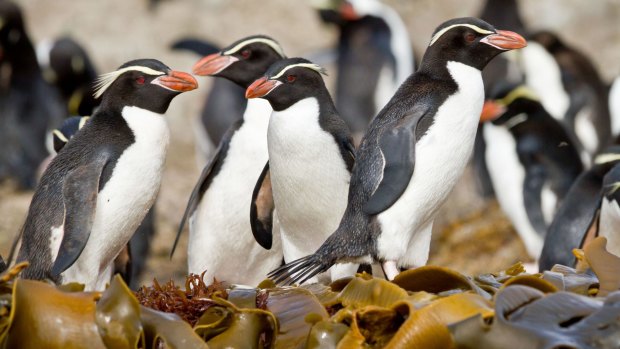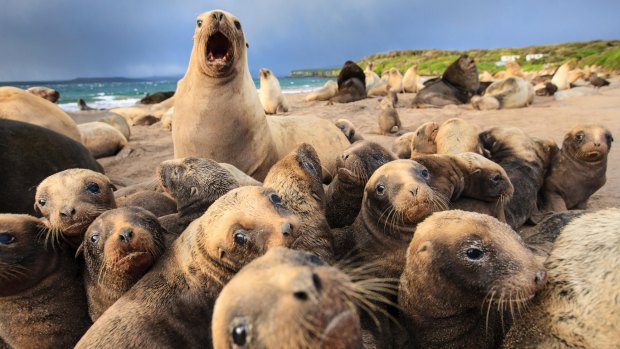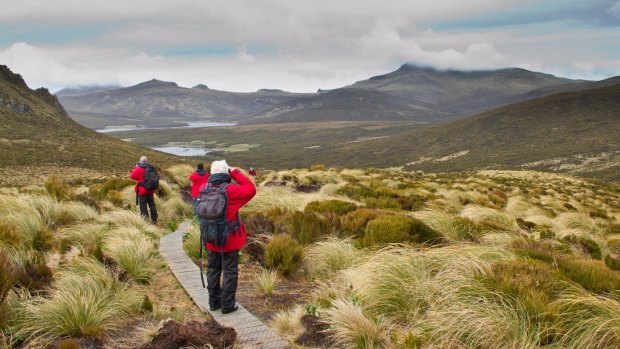This was published 6 years ago
New Zealand's Sub-Antarctic Islands: The ultimate eco-tourism destination
By Louise Williams

Crested penguins at The Snares, Sub-Antarctic Islands, New ZealandCredit: Shutterstock.com
This is, perhaps, the ultimate in eco-tourism. An island so pristine and so remote that the few visitors who reach its shores are not permitted to land. Instead, we catch our first glimpse of its giant "penguin slide" from aboard a Zodiac, the cold, dark water below undulating with giant kelp and the occasional seal.
The towering granite slope that runs down to the water looks like a busy highway as hundreds of rare Snares Crested penguins (with their yellow tufts and comical hunch) get on with whatever they were doing before our Russian ice-breaker, and its inflatable runabouts, showed up; a steady stream of penguins slide into the water as just as many clamber out.
"The Snares" are the northern most group of the wild, uninhabited Sub Antarctic Islands, that lie between New Zealand and Antarctica. These tiny dots in the Southern Ocean, sometimes called the Forgotten Islands, are among the least visited places on Earth. With no large land mass to temper winds as they howl across the chilly waters, it is here that the largest waves and strongest winds on the planet have been recorded. The islands serve as ecological "liferafts", providing critical breeding grounds and refuge for an abundance of unique wildlife, like the endangered NZ sea lion, numerous albatross and even a flightless duck, previously believed to be extinct. On land, the vegetation is just as stunning, strange and unique.

Sea lion breeding colony.Credit: Nature Picture Library / Alamy Stock Photo
It's partly the inhospitable weather that keeps the NZ Sub Antarctic islands mostly off the tourist trail. For the week we are at sea, we are entirely alone; not a single vessel even glimpsed on the horizon. But, the islands' isolation is also self-imposed. The NZ Government strictly limits visitor permits, and for good reason.
Here, scientists, conservationists and policy makers have, for decades, been seeking to answer a fundamental question. Can nature ever truly be restored? Given the slaughter unleashed by the sealers and whalers of the 1800s, and the many invasive species that arrived with ill-fated farmers and even early shipwrecks (rats are, indeed, quick to desert a sinking ship) – can the damage be undone? Could the NZ Sub Antarctic islands become a template for recovery elsewhere?
This is an achievement I want to see, albeit still a work in progress. So, too, our small group of 50 passengers. The islands have been protected since the mid-1970s and the systematic removal of invasive species, island by island, took off in earnest in the 1990s, with some spectacular results. Many of our group are our scientists themselves, some looking for exceptional birds or plants, some for elephant seals from Antarctica "hauled up" on the relatively temperate Sub Antarctic beaches. And, like me, some also have a personal interest, in the islands' equally fascinating past.

Sub Antarctic Islands, New ZealandCredit: Shutterstock.com
Our voyage begins in Bluff, New Zealand's most southern port. We've stayed overnight in the nearby city of Invercargill. At the local museum one historic (and, I hope, fanciful) account refers to a 35-metre wave. This, I calculate, is equivalent to a wall of water three times the height of our modest ship's bridge. There is an undeniable ripple of trepidation on our way up the gangway.
As the coast recedes from view, the siren goes for the lifeboat drill. It's an all-weather Artic pod, built to barrel-roll on large waves, with 40 people strapped inside. The crew closes the hatches leaving little to the imagination. We'd been asked to bring our medication; but no one else seems to have bothered. I find myself sitting trussed up in my all-weather gear and lifejacket, cheek by jowl in a stationary lifeboat, clutching perhaps the largest selection of sea sickness remedies the crew has ever seen. Outside the sun is shining and the seas are uncharacteristically calm.
In mid-summer the days are long and cool, and we won't encounter sea ice. But, our ship is leased by a small NZ expedition company that also visits Antarctica and the Arctic. So, an ice-breaker it is; comfortable and functional, but with none of the stabilisers or hotel features of a "cruise". Our chef, however, has come from direct from cooking for First Class passengers on a major international airline. Our meals are just as good.
The ship's crew is Russian. Our guides are bird, flora and mammal experts from New Zealand and beyond, some taking time out from university and research jobs. There isn't much they don't know about the weather and the wildlife; including how to repel a young sea lion when all you have on hand is a backpack (and to avoid wearing beige on the beach with sea lions, or you could be mistaken for "one of the girls") We passengers are a mixed bunch, but with no TV, devices or connectivity, there's plenty of conversation to be had, especially about the many species we've spotted and the current state of our "sea legs".
The Snares is our first stop. That no invasive species took hold here, despite sealing in the 1800s, is considered both an environmental mystery and a miracle. The Snares' granite foundations are 100 to 200 million years old, fragments of the super-continent, Gondwana. That history is unbroken. Today, the island is among the rarest places on Earth; teeming with life unaltered by man. It's a humbling thought.
We then head south to the larger Auckland and Campbell Island groups, where rodents, rabbits and feral cats and farm animals wreaked havoc. Environmental recovery is, by contrast, a long, hard ongoing slog. Here, daytime landings and hikes are permitted in several spots.
Incredibly, the weather is mostly fine, as we circumnavigate Enderby Island, to the north of the Auckland Islands group, spongy peat underfoot. It's a day-long trek, from the white sand landing beach with its busy sea lion nursery, overland to the cliffs, covered with nesting sea birds, then through thick grasslands and into an ancient, twisted rata forest. The canopy of these wind-stunted trees, ablaze with red flowers in summer, is so dense that it feels like we've stepped into another world. But, instead of meeting the lion in the magic forest of Narnia, we come face to face with a wandering sea lion and a hawk.
Painstaking eradication programs, right down to the last rodent, mean Enderby Island has been pest-free since 2001. Where rabbits once nibbled the grass down to bowling green stubble, the tussocks are chest-high, and the strange Sub Antarctic mega-herbs are flowering, their large leaves and spectacular blooms have apparently evolved to maximise the light during the short summer.
There's no walking track, just a general rule: give way to the wildlife. The yellow-eyed penguin is shy, the rare crested parakeet is a brief flash of green, and the fledgling albatross in their nests mostly just look surprised. But, NZ sea lions are an engaging, curious lot, and surprisingly agile on land. If you're being followed don't run – you'll just start a game.
It's a privilege just to be here. On the NZ mainland, sea lions were hunted to extinction in the 1800s. Today, they are critically endangered and confined mostly to the Sub Antarctic.
I feel I have a personal stake in the success this recovery effort. I grew up with fabulous tales of mountainous seas, shipwrecks and heroic rescues in the Southern Ocean. My grandfather was a ship's captain and, as a young cadet in the early 1900s, he had trained on a NZ government sailing ship. Its role was to leave provisions in "castaway" depots on these same Sub Antarctic islands, and to stock them with farm animals like goats and pigs. The "castaway" depots were supposed to sustain survivors of shipwrecks for the months, or even years, it would take to be picked up – 112 survivors from nine shipwrecks did make it to shore between 1833 and 1908.
Then, steam replaced sail, and the big Southern Ocean winds and trade routes were forgotten. For decades the depots and ghost farms were left to the vagaries of nature. On the Campbell Islands and elsewhere, untended flocks of sheep developed self-dropping fleeces, rabbits, goats, pigs and rodents decimated the vegetation and feral cats wiped out many native birds. The castaway depots weren't so heroic after all.
In the Campbell Islands group, our next stop south, we take an evening Zodiac "cruise" around the foreshores. Given the mesmerising antics of the local rockhopper penguins, it would be easy to overlook an unremarkable brown duck partially concealed by the rocks. Our guide makes sure we don't. It's a Campbell Island flightless teal, one of the world's rarest birds. These teals were long thought to be extinct, likely wiped out by feral cats. Then, in 1975, a small group were rediscovered on a remote outer island of the Campbell group. They were bred in captivity and successfully reintroduced. They're back from the brink.
There are still, of course, other threats beyond the islands' shores, particularly overfishing and climate change. But, it's hard not to feel elated. And, we're especially fortunate; the weather is spectacular, the seas relatively kind, the company terrific and my oversupply of sea sickness medication left mostly unused.
Before flying back to Australia, we stop in the southern NZ city of Dunedin, where, at St Clair beach, there is a statue of a sea lion called "Mum".
In 1993, this lone NZ sea lion swam hundreds of kilometres from the Sub Antarctic islands to give birth here, the first sea lion to return to the NZ mainland in 150 years. Over many years, "Mum" kept coming back and had 11 pups on the same beach – who then had their own pups - establishing the first new colony since the 1800s. Like the teal, they're precious and precarious – but they're back.
Louise Williams travelled at her own expense.
TRIP NOTES
FLY
Air New Zealand from Sydney to Christchurch (3 hrs 45 mins), with a connection to Invercargill (1 hr 25 mins) See airnewzealand.com.au/
TOUR
Heritage Expeditions has five departures a year to the Sub Antarctic islands between November and January, of of eight to 19 days at sea. The ship accommodates up to 50 passengers. All island groups are nature reserves and landings sites are limited. Some sightseeing is from the water aboard Zodiac runabouts and, where permitted, guided hikes are available. Options range from all day treks in challenging terrain to easier walks on tracks and visits to historic sites. Waterproof clothing and footwear are essential.
heritage-expeditions.com/cruises-expeditions-in-subantarctic-islands-voyages/
STAY
Passengers leave from Invercargill, and travel by bus to the port at Bluff. Invercargill is a small friendly town with some good accommodation and dining options. The Quest Invercargill is a converted old bank with large comfortable rooms, located in the city centre in walking distance of all services
Sign up for the Traveller Deals newsletter
Get exclusive travel deals delivered straight to your inbox. Sign up now.